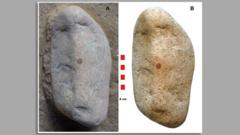Scientists in Spain have made a groundbreaking discovery that may redefine perceptions of Neanderthals' intellectual and artistic capacities. A research team announced the finding of what they consider the oldest complete human fingerprint on a rock, believed to resemble a human face, which indicates that Neanderthals possibly practiced art approximately 43,000 years ago. This pebble, found in the San Lázaro rock shelter in Segovia, shows signs of a finger dipped in red pigment to create a nose-like dot.
María de Andrés-Herrero, a co-author of the study from the University of Complutense, expressed excitement over the find during a recent interview, emphasizing the significance of the "strategic position" of the painted mark. This positioning suggests that Neanderthals had the capability for abstract thinking and symbolic behavior. The ongoing debate regarding the artistic abilities of Neanderthals has gained momentum thanks to this newest evidence.
Excavation efforts began five years prior, with the team uncovering the pebble beneath 1.5 meters of Neanderthal sediment by 2022. Scholars initially found the artifact surprising, noting it was larger than other stones unearthed at the site, alongside a vivid, red dot that evoked the appearance of a human face. Following extensive testing, researchers confirmed that the pigment was indeed ochre.
This discovery necessitated cooperation with Spain’s scientific police, which aided in conducting multi-spectrum analyses. These updates concluded that the fingerprint likely belonged to an adult male. Despite the findings, the challenge lies in the absence of existing Neanderthal fingerprint references, making definitive identification difficult.
During a press briefing, Spanish official Gonzalo Santonja articulated that this pebble represents the oldest known painted portable artifact in Europe, marking it as singular in its illustrative context. Further studies indicated that the distinct fingerprint arose from a non-utilitarian setting, implying that the mark left on the pebble had artistic intentions.
The notion is that a Neanderthal noticed the stone's unique fissures and deliberately marked it with ochre, as the pigment source does not occur naturally at the shelter. The research published in the journal Archaeological and Anthropological Sciences adds a valuable layer to the understanding of Neanderthal symbolism, characterizing the pebble as a visual symbol that could potentially denote portable art within certain frameworks.





















